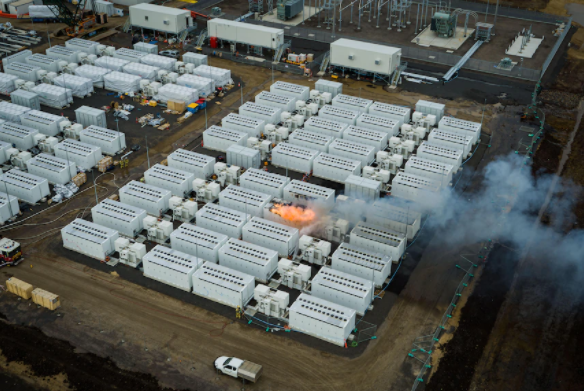Sunset and calm weather provides the perfect opportunity for rent-seekers profiting from the market chaos that follows.
The owners of fast-start diesel and gas-generators make out like bandits, as the spot price for power goes from less than $100 per MWh to tens of thousands of dollars per MWh.
Couple a sudden collapse of wind and solar output with a surge in demand (think a breathless 40°C day with the sun setting and air conditioners running at full throttle).
In Australia, this means the spot price often runs all the way up to the regulated price cap – when spot prices can (and often do) hit the $15,500 per MWh cap. Some might call deliberately engineered opportunities for market manipulation theft; others an investment prospect with no downside.
The owners of fast-start peaking generators are not alone in seeking every opportunity to gouge unwitting and defence-less power consumers.
As Paul Homewood outlines below, Britain’s large-capacity battery owners are just as eager to cash in on the volatility that comes with purporting to rely on weather and sunshine-dependent power generation.
Battery Energy Storage Systems
Not a Lot of People Know That
Paul Homewood
19 February 2024
There has been discussion of solar farm projects which include battery storage. (Battery Energy Storage Systems, or BESS).
The claims of the developers and renewable lobby is that storage will help to make intermittent renewables work.
By coincidence Timera have just published this update, which reveals it is nothing more than a money making ploy:
Impact of new balancing platform on GB BESS
Batteries create value from harvesting price volatility. The real time Balancing Mechanism (BM) has the most volatile prices in the GB market, yet battery (BESS) assets have captured limited BM value to date.
BESS BM value capture has historically been impacted by:
-
- Manual dispatch of flexible assets by the System Operator (ESO), disadvantaging smaller asset dispatch
- The 15 min rule where BESS bid offer acceptances are effectively limited to 15 mins of duration (given issues with the ESO’s visibility as to state of charge)
- Skip rates where the ESO has consistently chosen higher priced assets over BESS in the BM (reflecting issues 1. & 2. above, but also real constraints that the ESO faces in managing the system e.g. locational requirements to use thermal assets).
There has been significant progress in 2024 in addressing these factors with the introduction of the ESO’s new Open Balancing Platform and a relaxation of the 15 min rule.
In today’s article we look at the impact of these changes on BESS asset dispatch in the BM.
The rest is technical, but the key is this opening sentence:
Batteries create value from harvesting price volatility
As Timera note, the Balancing Mechanism (BM) has the most volatile prices in the GB market. This is because of the inherent unreliability of wind and solar power. When supplies are short, the Grid is forced to step in and buy up short term power supplies wherever it can get it.
Prices can obviously go sky high, and it is trading at these times where the battery storage operators can make a handsome return. These costs of course end up being added to consumer bills.
In short, solar/battery farms can make large profits from the very intermittency which they create.
None of these battery storage systems will solve the problem of how to store solar power in summer for use in winter, when generation falls to about 3% of capacity. Instead they are designed to store power during the day, to use at night.
The giant Project Fortress solar/BESS farm in Kent, mentioned by Ray Sanders, is rated at 373 MW, with 700 MWh of battery storage. That’s less than two hours’ worth.
Not a Lot of People Know That




How is the solar/wind scam different from Holland’s early 17th century tulip mania?
You could eat the bulbs when you were hungry, as the cabin boy did with one prized specimen. Solar panels and wind turbines have no nutritional value.
If only a cabin boy could eat a solar panel or wind turbine blade….
He would have to be very hungry.
Stop Trudeau’s election reform.